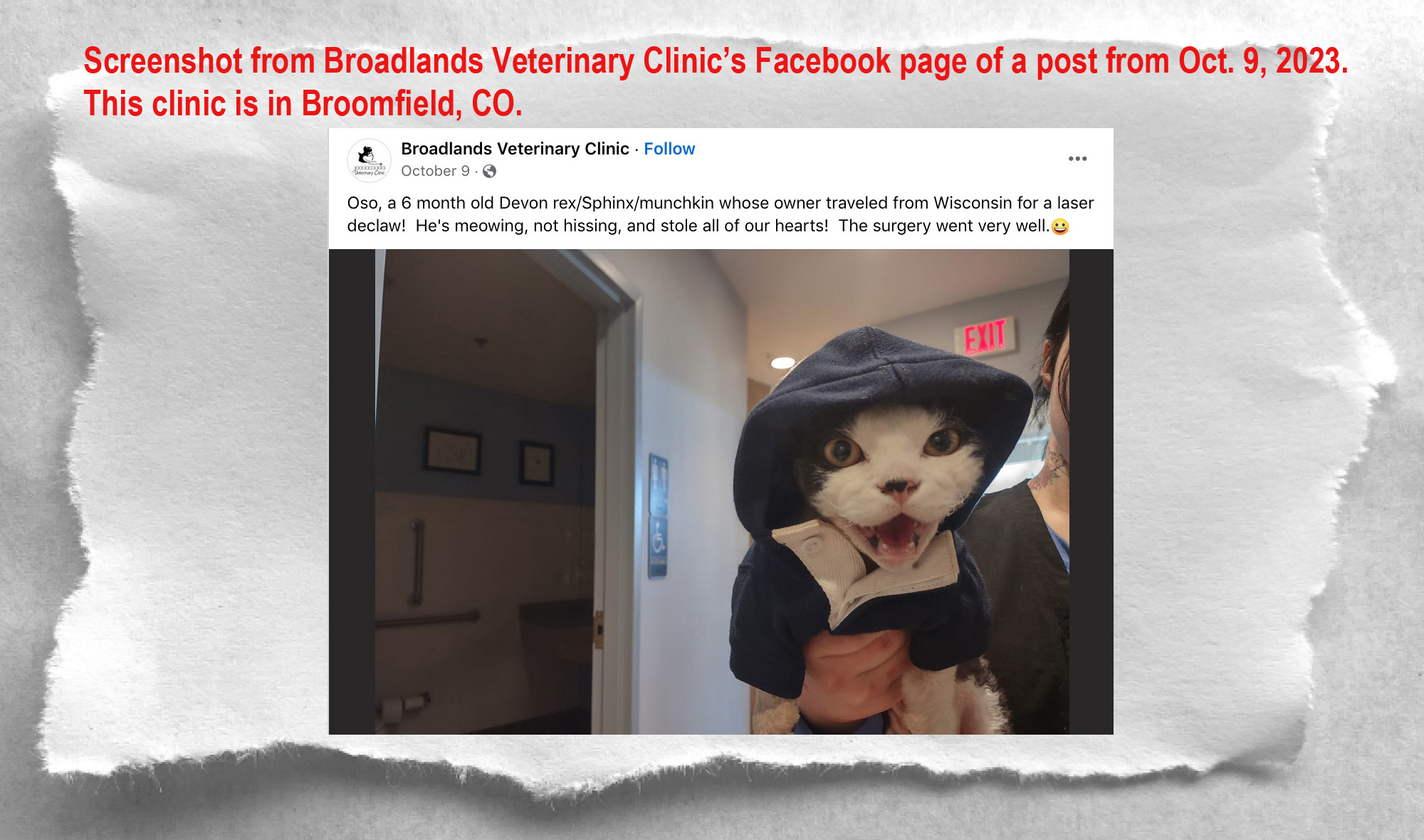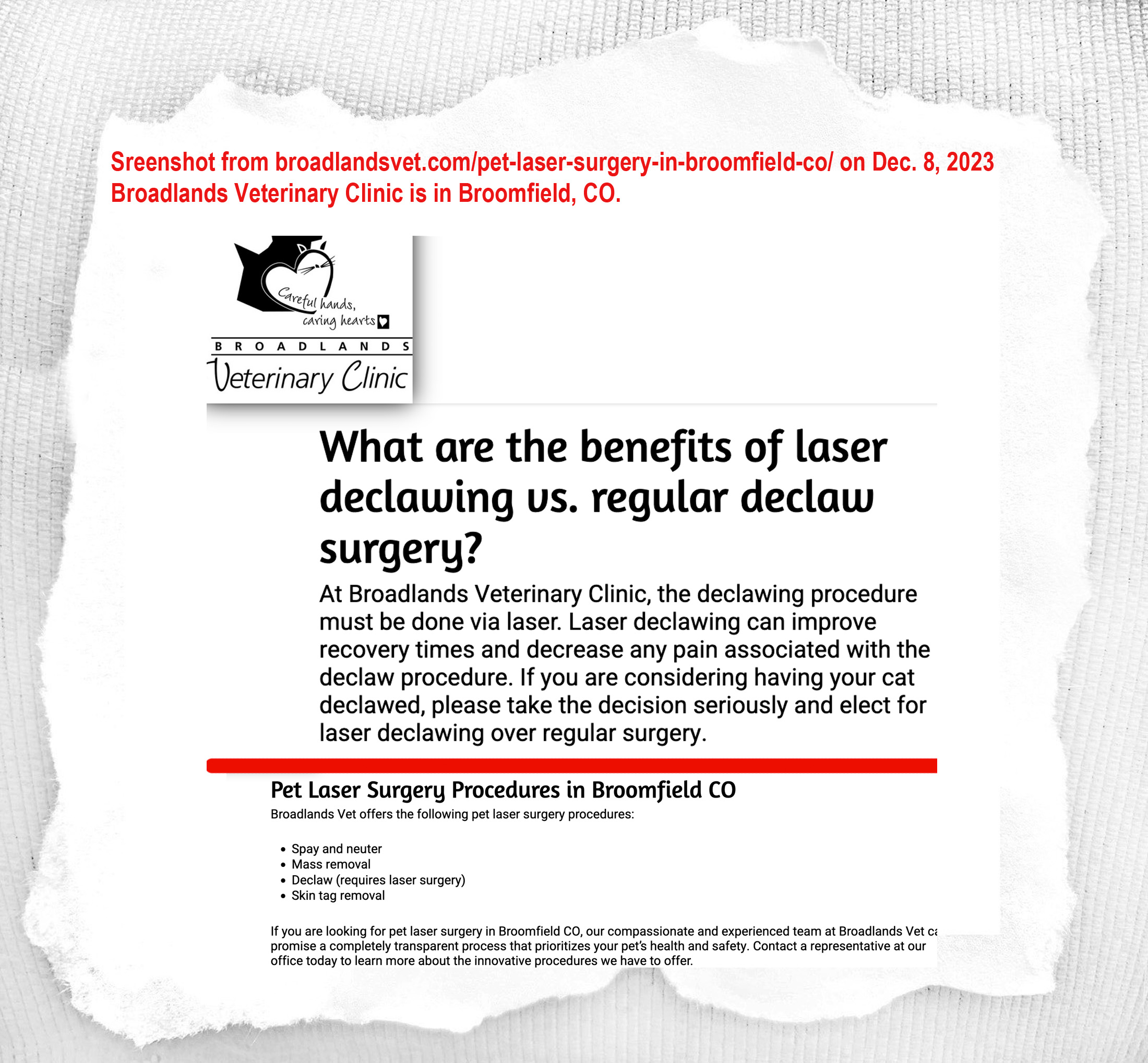Here’s a photo from Broadlands Veterinary Clinic’s facebook page that was posted on Oct. 9 , 2023. Broadlands Veterinary Clinic’s facebook page
We have withheld the names of employees for fear that they might suffer a backlash for their honest answers.
Fair Use Act disclaimer.
This story is for educational purposes only. Copyright disclaimer under section 107 of the Copyright Act of 1976, allowance is made for “fair use” for purposes, such as criticism, comment, news reporting, teaching, scholarship, education, and research.
Link to laser declawing info. https://www.broadlandsvet.com/pet-laser-surgery-in-broomfield-co/
We wanted to look into how Broadlands Veterinary Clinic in Broomfield, CO addresses declawing so we made a short call to their clinic. Here’s what we found.
Researcher asked for the cost of a neuter/declaw and what vet/surgeon does their declaws.
Employee said, “Yes, she actually uses laser as well for the declaws. I think we are the only clinic left in, well there’s a few, but that do actual laser declaws.”
Researcher asked, “In Colorado?” The employee said, “There are a few who do it (declaw) but they don’t do it with laser.”
Employee said the laser has less bleeding, they wake up a lot better, and they keep bandages on for 3 days and depends on if they are over 5/7 lbs if she glues or sutures them.
Researcher asked if the cats are ok long term after the declaw and the employee said yes. They said as long as you use paper litter for three weeks. They said at first the cat might be more sensitive when they walk but they have seen them walk normal right after their declaw.
Researcher asked if she does declaws regularly and the employee said, “Oh yes.”
Researcher asked if she does one a week and the employee said, “It’s actually maybe 3 or 4.”
A neuter/ 2 paw declaw is around $1454.
They said that Dr Erin Perkin is their vet who does the declaws. They said she’s being doing them for over 20 years.
They said that they don’t do 4 paw declaws because the cat can’t scratch the furniture with their back legs.
It says on Dr Perkin’s website that she is a member of the AVMA and CVMA. (Colorado Veterinary Medical Association.)
“Memberships
- American Veterinary Medical Association
- Denver Area Veterinary Medical Society
- American Mensa Society”
Here’s the CVMA’s 2014 declawing position statement.
CVMA Position Statement on
Declawing (Onychectomy) of Domestic Cats
The Colorado Veterinary Medical Association is opposed to the declawing of domestic cats as a routine
procedure. In most cases, declawing is not a medically necessary procedure. The decision of whether to
declaw should be a collaborative one between owner and veterinarian, and broached only after all other
alternatives have been exhausted.
Veterinarians have an obligation to provide cat owners with complete education in regard to declawing
prior to performing the procedure. The following points are the foundation for full understanding and
disclosure regarding declawing:
Owners should be educated about the fact that scratching is a normal feline behavior, providing a
means for cats to mark their territory both visually and with scent, and is used for claw
conditioning (“husk” removal) and stretching activity.
Prior to considering declawing, owners should attempt to manage undesirable scratching by
providing suitable implements for normal scratching behavior. Examples are scratching posts,
cardboard boxes, lumber or logs, and carpet or fabric remnants affixed to stationary objects.
Implements should be tall or long enough to allow full stretching, and be firmly anchored to
provide necessary resistance to scratching. Cats should be positively reinforced in the use of these
implements. In addition, appropriate claw care, consisting of trimming the claws every one to two
weeks, should be provided. Temporary synthetic nail caps are available as an alternative to
onychectomy to prevent human injury or damage to property.
Declawing may warrant consideration when scratching behavior is an issue that threatens the ability
for a particular cat to remain in the particular home. In some cases declawing will protect/preserve
the human-animal bond.
Declawing may be acceptable when all other attempts have been made to prevent the cat from
using its claws destructively or when clawing presents a significant health risk for people within the
household, thereby placing the cat at risk of relinquishment or euthanasia.
There are inherent risks and complications with any surgical procedure including, but not limited
to, anesthetic complications, side effects associated with analgesics, hemorrhage, and infection.
Declawing (amputation of the last bone of the toe) is a painful procedure and must be performed
using proper techniques and administering effective pain management during and after the
procedure.
CVMA condemns performing declawing without appropriate perioperative analgesia. Poorly
managed perioperative pain may lead to chronic neuropathic pain and deterioration in quality of
life.
(continued)
CVMA Position Statement on Declawing (Onychectomy) of Domestic Cats – Page 2
If declawing is performed, safe and effective anesthetic agents should always be used. Furthermore,
the use of safe and effective perioperative analgesics for an appropriate length of time is imperative.
The concurrent use of two or more pharmacological classes of analgesic drugs (opioids, alpha-2
agonists, anti-inflammatories, local anesthetics, dissociative anesthetics) generally provides more
effective pain control, with fewer side-effects, than therapy with a single drug. Postoperative
analgesics should be dispensed to the owner to give for 4-7 days post-surgery or as long as needed.
Declawing of the front feet is usually sufficient; declawing all four feet is strongly discouraged.
Declawed cats should be housed indoors only.
Note: This position statement is based on CVMA Principles of Animal Welfare, CVMA member feedback, and adapted
from position statements from the American Veterinary Medical Association, American Animal Hospital Association, and
the American Association of Feline Practitioners.
Approved by the CVMA Board of Directors on November 8, 2014


